The Shinto Festival of Ise, in Japan
Tokyo, October 22nd, 1889
If it be worth while - and few will deny that it is so - to seize such fleeting opportunities as are still now and then permitted to us of photographing the old ways and ceremonies of the interesting land first introduced to Western ken by Marco Polo, six centuries ago, under the name of Zipangu, then, assuredly, the subject of this letter may well enough claim a hearing in the columns of The Times.
My story today is of an old-time spectacle appertaining to Shinto - at once the primitive, yet still living and ruling, faith of the Japanese people, and one of the most ancient religious systems in the world.
To this it may be added that, as the ceremonies which I shall describe take place but once in 20 years, and as no alien was present at them in 1869, nor any but myself on the occasion lately ended, the writer of these lines is, and must in the nature of things be for 20 years to come, the sole foreign eye-witness, living or dead, of the great festival of Ise, which is by far the chief and most rare of all its kind in Japan.
Readers of my letter on the Shrines of Ise in The Times of the 27th of last December may remember that, in a tolerably full account of the temples and matters relating to them, I pointed out that the hoary antiquity of those hallowed seats of worship is the antiquity of type and of establishment, not of the fabrics themselves.
I showed that, being built only of plain spruce and thatch, exactly after the primitive fashion of the buildings that prevailed in Japan before the birth of Christ, the two great shrines at Yamada - namely, the Naiku, dedicated to the Sun Goddess, who is regarded as the ancestress of the Imperial line, and the Geku, dedicated to the Goddess of Earth - suffer impairmenmt so rapidly in the damp and variable climate of Japan that it has been the practice for the last 12 centuries to renew them every twentieth year.
I dwelt upon the extraordinary care that has been taken on all such occasions to preserve the ancient style most faithfully in every detail, so that each successive group of structures should be an accurate copy of the last.
I further explained that, instead of pulling down one set of fabrics and building another in its place, the Japanese plan for each temple is to have two precisely similar sites, contiguous to one another and alternately occupied, the old set not being dismantled until its counterpart is finished and made ready to become the new home of the venerated emblem of the deity, in which latter, be it what it may, is incorporated and centred the sacredness of every Shinto shrine in the empire.
Many elaborate ceremonies, 17 in all, mark the various stages of the six months' operations that comprise the whole undertaking of building the new structures and vacating the old ones.
For both the Naiku and the Geku those ceremonies are virtually identical.
To see one is to see both.
Two only of either series, however, may be witnessed by any of the lay public, no matter how exalted.
Yet, fortunately, one of the two is by far the greatest of them all, and that is the Sengyo, or "change of the temples" - in other words, the transfer of the sacred symbol from its old to its new abode.
During the Middle Ages, the Ise shrines, though always the head-quarters of Shinto, frequently had hard times and embarrassments to contend against.
It is true that the Emperor Temmu's ancient decree, ordaining the reconstruction of the buildings at every second decade, had never been departed from.
But, what with such hindrances as internal commotions, the powerful rivalry of Buddhism, and the ascendency of military power - with, as its result, the eclipse of the true monarch, who has ever been the centre and embodiment of Shinto - the temples and the observances connected with them came at times to be sadly neglected, and the establishment at Yamada fell into a state of decadence from which it had but partly recovered at the 59th celebration, in 1869.
This year, however, which sees the country quiet and the Emperor firmly reseated on his temporal throne, no pains were spared to re-establish the old order of things, to carry out the entire series of ceremonies strictly according to the ancient canons and practices, and especially to effect the "change of the temples," not only with the solemn ritual and accessories befitting their dignity and their venerable history, but, it is said, on a great and imposing scale, never perhaps equalled hitherto.
Plainly, therefore, the Sengyo of this year was an opportunity not to be missed, an opportunity that perchance - but this may Allah forbid! - will never occur again.
How I seized it, and what, armed with credentials kindly furnished to me by the Home Minister, I had the pleasure of seeing, at the Geku Sengyo, on the 5th inst.will appear further on.
Meantime - but first asking forgiveness for the above dry though very necessary preface - let me invite your readers to come and enjoy with me for a while, in the picturesque thoroughfares and neighbourhood of Yamada, some of the characteristic sights of a Japanese jubilee.
And let us begin our pilgrimage at the delightful little park on the northern threshold of the town.
Bright, indeed, and joyous is the scene around us on this perfect early-autumn morning.
Grand torii of evergreens, artifical lakes, reflecting the festoons of countless crimson lanterns that span them overhead; hard by, the solemn forest aisles which lead to the Geku shrine; overhead, the pleasantly warm October sun, shining out of a blue sky that is here and there dappled, far aloft, with fleecy patches of cloud; and everywhere a dense, patient, inquisitive throng, consisting almost wholly of those lower orders of the people who, after all, are the great charm of Japan, and who here exhibit faces alternately indicative of wild astonishment at the day-fireworks that every now and then shoot up into the firmament, and of bewilderment at the cries and exhortations of the swarm of showmen, cheap-jacks, mountebanks, and quacks that line the townward margin of the park.
And what man is there with a spark of human kindness in his disposition who can easily tire or grow impatient of a truly Japanese holiday crowd?
Surely, for happiness, gentleness, and sobriety, for soft-voiced and always smiling chatter, for the blessed faculty of inhaling healthful enjoyment from the simplest things, and for the lucky possession of bodies and limbs that hours upon hours of weary tramping and sight-seeing are utterly unable to exhaust, no other country can even profess to show the match of a festival crowd in Japan.
Police in such a throng, it seems to us, can have nothing to do; and somehow one cannot help wishing that, for all their admirable urbanity and devotion to duty, these guardians of the peace would take themselves and their neat foreign uniforms away from a festival whose every association and every thought belong to the olden days and the oldest traditions of this charming old land of Dai Nippon.
Meanwhile, we thread our way, Naiku-wards, through the press of men and women, lads and lasses, and swarms of bright-faced children.
Shades of gray, indigo, and scarlet are here, as everywhere else in Japan, the prevailing colours in the costumes of the crowd.
We rub shoulders with sturdy, smooth-skinned farmers and fishers, and not a few workmen in the bold uniforms of their guilds; with the dear wrinkled old women, whose skirts are gathered up to a height that is just a little startling, and even suggestive of doubts as to the real utility of the long blue leggings that so neatly encase their shrunken limbs; and black-eyed, gipsy-brown lasses, in the whitest of socks and the reddest of petticoats, with their precious coiffres shrouded from the dust by blue-and-white cotton towels so artistically tied as to give them a killing, coquettish air, of which, true daughters of Eve that they are, none are better aware than themselves; and fat wenches with twinkling eyes, who are absolutely running over with excitement as they waddle along under their great paper umbrellas; and spicy, proud-lipped little belles of the better class, riding in jinrikisha, and all ablaze with the splendour of their dainty butterfly robes; and, lastly, those tiny, chubby boys, whose young pates are so quaintly and severely shaved that the too deft barber seems to have only left them just hair enough to swear by.
Such, with a sprinkling of gentlefolks and tradespeople here and there, is the tide of human beings that for this gay week ebbs and flows in two compact streams, from morning till night, over the long highway that connects the great twin temples of Yamada.
Happy-hearted and kindly poor of Japan!
How contented they look, how cheery, and always how clean!
How well they relish, in their own humble, artless fashion, the festival that most of them have trudged scores of miles to see !
And how simple and tender withal are the feelings of devotion with which they will presently approach these greatest of all the 128,000 and odd Shinto shrines in the empire, always loyally mindful that Ise is the chief worship-seat of the celestial hierarchy whose august descendant, sitting on the throne of Japan, as his ancestors before him have done for these 1,000 years and more, rules ever beneficently and wisely over the land and its people and all that is therein.
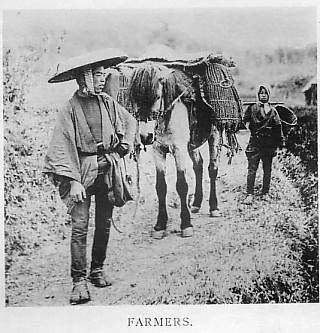
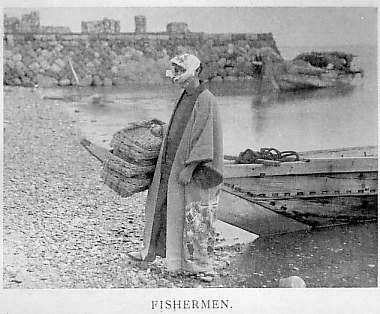
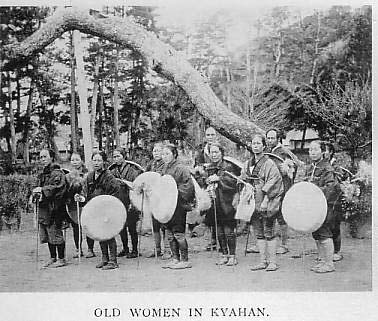
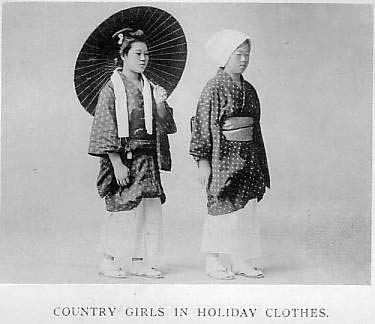
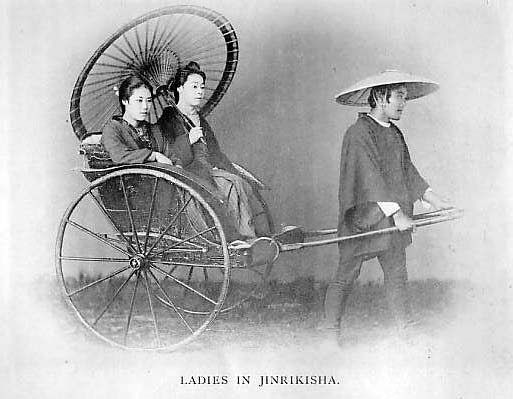
Hardly less warm than our appreciation of Japan's sunshiny people is that called forth by the street-scenes which enliven our way - as, for instance, the roaring trade that is being driven at the cook-shops, tea-houses, and inns; the fruit-stalls, with their rows of red-gold persimmons and piles of bloom-clad grapes; the happy parties at their meals in the distant inner rooms; the tempting confections of rice and fish, sweet potatoes, pickles, maccaroni, and mushrooms; and the stalls of the lemonade sellers; and the bazzars full of curios, sweetmeats and toys; and the poor distracted servant-girls, staggering about with the great tubs of steaming rice that are always getting empty - and no wonder; and the hurry and cackle and laughter in every quarter.
As for the shows, they are legion, and of the most astonishing kinds.
There is a Bandaisan of course, so startling that Professor Sekiya himself would hardly know it again; and a diver in full regimentals, who goes down as readily with the fisher-folk, intent on "sea-ears," as he is doubtless able to do in the sea itself.
As in duty bound, we pay our penny at a booth on Ai-no-yama to see an historical dance after the manner of the fair and famous O Sugi and O Tama - performed, alas! by two little scare-crows of maids in a style fit to make the poor dead artistes turn uneasily in their graves, though presumably the dresses are correct.
Then the Bridge of Uji, with its row of bare-legged beggars stretched across the shallow stream-bed 30 feet below, waving their mighty gaping bag-nets with such a persuasive, beseeching air as to make them seem almost human, and invoking blessings on our heads as well as coins out of our pockets, not one of which latter, we may be perfectly sure, will the dexterous fraternity let pass them throw we never so wisely.
Then, at last, after our three miles' walk, the sombre shade and stillness of the stately Naiku grove, with the quaint old-world temple structures nestling in its midst, where let us hope that they and their successors may be left in peace for "so long as the sun shall warm the earth."
 Then, of course, after tiffin a la Japonaise at that charming tea-house the "Wistaria," on the bank of the Ikutagawa, we set off, as all true pilgrims should do, for Futami-ga-Ura, greatly famed in song and story, and distant no more than three or four miles, on the shore of the Gulf of Owari.
The route thither is pretty enough, at first passing over rocky, wooded uplands, and later through richly cultivated fields in the littoral plain, now heavy with golden rice, and dotted with picturesque groups of peasants, who are this very day beginning the harvest.
Evidently also to-day is a kichi nichi, or lucky day for marrying.
For here, as we approach the seaside village of Futami, comes a rustic wedding procession, on its way from the bride's old home to her husband's.
At its head trot three or four couples of "proud young porters," laden with great chests full of the bride's ceremonial presents and belongings; and after them, in jinrikisha, come the go-between and others, escorting the bride herself.
She is tastefully arrayed in her wedding garments, and oh! how powdered and rouged; and she looks calm and happy enough until those abominable jinrikisha-men of ours raise such a chorus of laughter that the poor girl blushes indignantly through her cosmetics, and we ourselves feel the sorest of longings to wring their wicked necks in her presence.
Next we come to our destination and alight at the Hinjitsu-kan, or "Sun-inviting Mansion," the Japanese club to which we have an entree by the kindness of the Governor of the province.
A goodly place it indeed is, this Futami on the Ise Sea; and most justly, as we think, have the nature-loving Japanese given it high rank among the beautiful spots of the Empire.
A long curved strip of the purest and finest shingle beach; straggling pine trees and the grateful odour thereof ; blue sea for a fore-ground, crisped by a gentle breeze, dotted with the sails of quaint barques and picturesque fishing-boats, and washing the shores of the loveliest bays and of whole archipelagoes of rocky, timber-clad islets; and there, standing out in the sea at the rocky point near at hand, the curious old Mioto-seki, or "wife and husband stones," with their associations and traditions and the great grass rope that connects them - this, as we see it, is Futami.
We know that yonder, across the gulf, we ought also to see the distant silhouettes of Fuji-san the peerless, and Asamayama, and Ontake-san, and Haku-san, and a host of other hill monarchs.
There is a warm haze, though, this afternoon, which robs us of that treat; and we may surely, in all conscience, rest content with what we have.
Not, however, without a thought of how different this scene, so fair to-day, must have been on that terrible evening, only three weeks ago, when, as the great typhoon of the 11th of September, with its diameter of fully 200 miles, swept over this part of Japan, the very spot we stand on can hardly have been 20 miles from its centre.
As for the Hinjitsu-kan, it is the perfection of a Japanese building, chaste, tasteful, and with neither spot nor blemish; and what more need be said of it than that, except it be to tell of the treasures, well revered of the members, in the guest-room upstairs - to wit, the great scroll in the alcove, which was written by the hand of his Imperial Highness Arisugawa-no-Miya, and the fine bronzes in the same room that are the gift of the Dowager Empress.
Later we stroll over to the Mioto-seki, and give an hour or so to that charming historical spot-with its tiny cave-shrine of the Sun Goddess, where the lights are always burning; and the shops that sell at such microscopic prices the conches and sea-shells and other keepsakes of the kinds which pilgrims love; and the little temple of the long name beginning with So-min, that good villager who gave shelter to Susano the Moon-God, and who was very properly thereafter guaranteed against pestilence by a straw waist-girdle, the gift of the deity, and assuredly the first cholera-belt that was ever made; and the rock-niche that once accommodated the whole company of the gods; and the waves, plashing lazily over the feet of the "husband and wife;" and the straw rope which binds that ancient couple, rather loosely, together; and, lastly, the rude wooden altar, with its diminutive gohei and torii, where, at the hour when the "silver dawn spreads over land and sea," pious devotees of the Sun-goddess are wont to gather while the pilgrim season lasts, humbly awaiting the instant when the first flash of sun-beams shall come to them across the smiling sea, right through the gap which separates the Mioto-seki, that they may thereupon fall down before their patron luminary, and reverently offer up their simple tribute, which, indeed, besides prayer and praise, consists of nothing but poor circlets of straw.
Then, of course, after tiffin a la Japonaise at that charming tea-house the "Wistaria," on the bank of the Ikutagawa, we set off, as all true pilgrims should do, for Futami-ga-Ura, greatly famed in song and story, and distant no more than three or four miles, on the shore of the Gulf of Owari.
The route thither is pretty enough, at first passing over rocky, wooded uplands, and later through richly cultivated fields in the littoral plain, now heavy with golden rice, and dotted with picturesque groups of peasants, who are this very day beginning the harvest.
Evidently also to-day is a kichi nichi, or lucky day for marrying.
For here, as we approach the seaside village of Futami, comes a rustic wedding procession, on its way from the bride's old home to her husband's.
At its head trot three or four couples of "proud young porters," laden with great chests full of the bride's ceremonial presents and belongings; and after them, in jinrikisha, come the go-between and others, escorting the bride herself.
She is tastefully arrayed in her wedding garments, and oh! how powdered and rouged; and she looks calm and happy enough until those abominable jinrikisha-men of ours raise such a chorus of laughter that the poor girl blushes indignantly through her cosmetics, and we ourselves feel the sorest of longings to wring their wicked necks in her presence.
Next we come to our destination and alight at the Hinjitsu-kan, or "Sun-inviting Mansion," the Japanese club to which we have an entree by the kindness of the Governor of the province.
A goodly place it indeed is, this Futami on the Ise Sea; and most justly, as we think, have the nature-loving Japanese given it high rank among the beautiful spots of the Empire.
A long curved strip of the purest and finest shingle beach; straggling pine trees and the grateful odour thereof ; blue sea for a fore-ground, crisped by a gentle breeze, dotted with the sails of quaint barques and picturesque fishing-boats, and washing the shores of the loveliest bays and of whole archipelagoes of rocky, timber-clad islets; and there, standing out in the sea at the rocky point near at hand, the curious old Mioto-seki, or "wife and husband stones," with their associations and traditions and the great grass rope that connects them - this, as we see it, is Futami.
We know that yonder, across the gulf, we ought also to see the distant silhouettes of Fuji-san the peerless, and Asamayama, and Ontake-san, and Haku-san, and a host of other hill monarchs.
There is a warm haze, though, this afternoon, which robs us of that treat; and we may surely, in all conscience, rest content with what we have.
Not, however, without a thought of how different this scene, so fair to-day, must have been on that terrible evening, only three weeks ago, when, as the great typhoon of the 11th of September, with its diameter of fully 200 miles, swept over this part of Japan, the very spot we stand on can hardly have been 20 miles from its centre.
As for the Hinjitsu-kan, it is the perfection of a Japanese building, chaste, tasteful, and with neither spot nor blemish; and what more need be said of it than that, except it be to tell of the treasures, well revered of the members, in the guest-room upstairs - to wit, the great scroll in the alcove, which was written by the hand of his Imperial Highness Arisugawa-no-Miya, and the fine bronzes in the same room that are the gift of the Dowager Empress.
Later we stroll over to the Mioto-seki, and give an hour or so to that charming historical spot-with its tiny cave-shrine of the Sun Goddess, where the lights are always burning; and the shops that sell at such microscopic prices the conches and sea-shells and other keepsakes of the kinds which pilgrims love; and the little temple of the long name beginning with So-min, that good villager who gave shelter to Susano the Moon-God, and who was very properly thereafter guaranteed against pestilence by a straw waist-girdle, the gift of the deity, and assuredly the first cholera-belt that was ever made; and the rock-niche that once accommodated the whole company of the gods; and the waves, plashing lazily over the feet of the "husband and wife;" and the straw rope which binds that ancient couple, rather loosely, together; and, lastly, the rude wooden altar, with its diminutive gohei and torii, where, at the hour when the "silver dawn spreads over land and sea," pious devotees of the Sun-goddess are wont to gather while the pilgrim season lasts, humbly awaiting the instant when the first flash of sun-beams shall come to them across the smiling sea, right through the gap which separates the Mioto-seki, that they may thereupon fall down before their patron luminary, and reverently offer up their simple tribute, which, indeed, besides prayer and praise, consists of nothing but poor circlets of straw.
But, as with us it is now much nearer sunset than sunrise, and as we must before all things be in good time for the great ceremony of the Sengyo, let us hie back at once to the Hinjitsu-kan, and thence, after one more cup of its most fragrant tea, to the deep sylvan glades of the Geku.
Six is the time fixed for the assembly of all the appointed functionaires at a building a short way within the second torii; and not long after that hour, at the third beating of a drum, we see the first stage of the ceremony-a procession of the entire phalanx to the old and about-to-be-dismantled shrine, a couple of hundered yards beyond.
They are to advance up the great avenue, now shrouded in the double gloom of night and of the mighty pines and cedars on either hand - a darkness that seems to be only made the more visible by the fitful gleams of woodfires planted at intervals along the roadside.
But as the column issues forth a blaze of torchlight from the pine-knot brands, ever increasing in strength, better illumines the scene.
It even casts gleams into the nearer depths of the grove itself, and here and there shows up the wonder-stricken faces of the devout crowds always peering through the palings of the avenue, where, poor folks, hundreds upon hundreds of them have been patiently waiting, ever since midday or even earlier, for what will be to most of them the greatest spectacle of their lives.
Among the leaders of the host are the Imperial Envoy and representative, Prince Kujyo, with the High Priest of the Shrine, and his Imperial Highness Prince Kuni, who is Conductor of Divine Services to the Imperial Family.
These and a few other personages, including the Governor of the province and the Civil Controller of Shrines, are clad in Imperial Court robes of the ancient style, swords only being omitted; and they bear in their hands simple sprigs of the sacred sakaki tree, to which hang little strips of cotton cloth, cut apparently gohei-wise.
Attended by a swarm of torch-bearers and a great cohort of swarthy-faced, white-clad priests and deacons, they advance, to the weird strains of ancient music, slowly and most solemnly up the time-hallowed forest aisle.
Presently the homely forms of the old temple buildings come faintly into view in the growing light, on the right-hand side of the way; and on reaching the entrance of the sacred enclosure the head of the procession turns in thereat, its members as they pass being here purified with salt-sprinkling by and attendant negi, or priest.
Gradually all file in.
Now, for a while, we part from them, it being ordained that none may pass therein save the actual participants in the sacred rites.
But that is no reason why we should not find out all that we can of what goes on, as well from the ritual books as from a certain freindly priest of high rank who is apparently off duty for an hour or so, and who obligingly takes us along to his cottage hard by, for rest and refreshment and chat.
And thus we learn that, first of all, the great dignitaries will lay their sakaki boughs on a table before the inner gate of the shrine, and solemnly dedicate them to the deity, all the rest of the throng humbly worshipping the while.
Whereafter, Prince Kuni and his associates, having received the sacred key from its keeper, will advance within the gate to the foot of the steps that lead into the Holy Chapel, or Sho-den, where the Imperial Envoy will reverently speak his master's message that the time for the change of the sanctuary has come.
Then, the doors having been opened by two negi, the Chief Priest and his deputies will ascend into the chapel, where all is so primitive and quaint, where the gloom is but feebly pierced by the rays from old-time earthern saucer lamps, furnished with wicks of common rush-pith and burning a vegetable oil, and where, in its nests of caskets and brocaded sacks, reposes the Sacred Mirror, which is the venerated emblem of the deity.
Meanwhile, those who are to carry the treasures and other symbols in the coming procession will draw near to the foot of the steps, receiving their burdens as handed forth by the priests.
And the On-Kinugaki, or silken fence, is also to be borne thither by 20 negi, in readiness to receive the divine emblem.
This Kinugaki, we learn, is a single strip of seamless white silk, above five feet deep, so carried as to form a closed hollow rectangle some 21 feet long and six feet wide, and thus to conceal all but the feet of those who may be inside it with their sacred burden.
For carrying it, 20 short bamboo rods are affixed at intervals to the upper edge of the curtain, and held by the aforesaid 20 negi.
The bearers within will be priests of high rank, specially chosen for the august office, who for days have undergone the strictest purification, and whose heads and hands are now closely muffled in white linen cloths; for no ordinary human eye may see, or hand touch, nor may the least breath of inferior man pollute, so much as the outermost casket of the heavenly symbol.
At the appointed time of removal, an officiating negi at the foot of the steps will shake thrice a fan of pine, in such wise as to imitate "the flapping of cocks when they cry out during the night" - so, at least, our informant says - and thrice will Prince Kujyo offer up at the same place the intimation of departure.
Then, after transference by the High Priest into its new receptacles, the emblem will be carried within the Kinugaki, and the latter be closed around it, and the whole procession be thereafter marshalled in its proper order of advance.
Such, we gather, are the main features of the rites of departure, according to the oldest and strictest canons, as followed here this day.
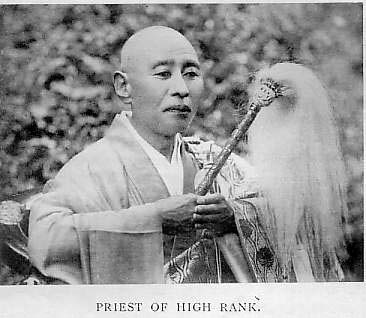
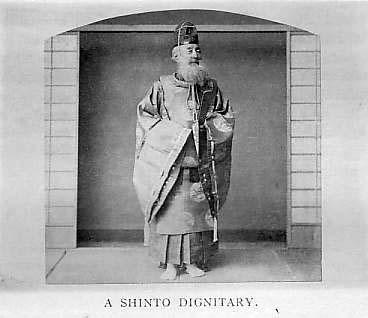
Eight o'clock is the appointed hour of departure, and punctuality will not fail, for the "Son of Heaven" and his Consort, in their palace at Tokyo, will at that moment engage in prayer on behalf of this great function at the ancestral worship seat.
As the hour approaches we return to our highly-priviledged post of observation at the threshold of the Geku, where we are so close to the path marked out for the procession that we know we may - though Heaven preserve us from such insolence! - even touch the very hems of the robes of the rank next to us.
Clean mats are now laid down in two paralled line from the torii we stand at to that which marks the entrance of the new shrine, a little further up on the opposite side of the avenue; and between these runs all the way a pure white linen strip, perhaps 3ft. wide, which no man's foot may defile, because it is the carpet of the holy symbol alone.
Presently, at the stroke of 8, and after a blare of trumpets from a military detachment near by, the van of the procession is seen coming outward from the courts of the shrine, and a subdued, yet, for all that, mighty murmur of excitement is heard from the surging crowd without.
As pioneer comes the State-Temporal, represented by the Prefect and the Civil Controller, who are clad in the loose flowing Court robes of olden days - black gauze over a scarlet tunic, with black silk girdles, purple silk hakama, mighty shoes (kutsu), apparently of papier-mache, lacquered black, and the quaint, high-curved black gauze head-dresses called kammuri.
With them are one or two other officials, in costumes that differ but little from the above, as well as a half-score white-clad officers of the buildings, and here, as everywhere, a numerous posse of lay-helpers and torch-bearers, all in garments of white.
Next a troop of priests, of many ranks, mostly in loose white silk robes - though some wear them of salmon colour - with white silk girdles, and glimpses of scarlet or purple vestments below, and the quaint, biretta-like, black hats called yeboshi, and, for all, the great kutsu, except a few of inferior grade, who alone go barefooted.
All of the above are divided into two equal ranks, advancing along the mats on either side of the sacred carpet, very, very solemnly, and in time with the melancholy dirge of Shinto music that is as yet heard but faintly far behind.
Now more priests in scores, bearing the sacred treasures, such as great arrow-shields, javelins, banners, sunshades, canopies, quivers of arrows, bows in exquisite brocaded sheaths or wrappers, and swords in the same; and among them all two pairs of great splendid symbols on lofty poles, one of which - the purple one-we are told is called Murasaki-no-Ompa, while the other, which is white, is the Sugi-no-Shishiha.
Everything in the procession is perfectly new as far as material or fabric is concerned, the Mirror and the brocaded bags that secrete it of course excepted.
But, on the other hand, the style and form are of the very oldest, being in each case an exact copy of the original as carried on through long ages from restoration to restoration.
The art workmanship, too, is of the finest kind, and no fewer than 36 examples of rare brocade, a high authority assures us, have been specially manufactured for the various treasures and their wrappings on this occasion.
Next to the treasure-bearing priests come musicians, playing on three kinds of instruments, called the fui, shichiriki, and wagon, the last, apparently, a kind of very old-fashioned koto.
After them, Prince Kujyo, representing the State-Spiritual, and clad much as the Prefect and Civil Controller, except that his Highness's robes trail for some yards behind him as he walks, and that his hakama are of black instead of purple.
And then, what a thrill is heard from the multitude without, and what a subdued, devotional clapping of hands and murmur of reverent prayer and praise, as all heads are bowed for the passaage of the Emblem of the Godhead, hidden within its simple tabernacle of pure white silk, and borne by six muffled, unseen priests over the pure white carpet already mentioned, which is being rolled up from behind, foot by foot, as no longer needed.
After the Mirror follows Prince Kuni, arrayed like the Imperial Envoy; and then the High Priest and his deputy, in their stately sacerdotal apparel.
Then more batallions of negi, and more treasures, and quaint canopies made of cedar-fronds, until at last the great procession has all rolled by, long before which its head has passed within the enclosure of the new sanctuary.
But into the proceedings that now take place there it is, perhaps, hardly necessary to enter, as their general nature may be sufficiently conjectured from what has been said about the rites of removal.
That the Sengyo ceremony and its accessories were as impressive and solemn as they undoubtedly were rare may be gathered from the foregoing only too feeble attempt to describe that which I take to be, after all, well-nigh indescribable.
Nothing, certainly, could well exceed the thorough beauty and picturesqueness of the scenes and the surroundings.
The calm and lovely October night; the noble glades, half-illumined by the glare of scattered torches and fires; the primitive outlines of the temple fabrics; the hushed multitude without, and the stillness within, that is broken only by the faint crackling of the fires or the fainter sounds of ritual in the courts of the shrine; overhead a narrow strip of sky, lit by a moon that is here unseen, yet not so brightly but that you may make out the stars well enough, and even patches of the Milky Way, which is Japan's "River of Heaven;" and then, at length, that imposing sacerdotal procession, with its features inherited from Japan's remote and wonderful past, and which not even the most world-hardened man, I am sure, could behold without true feelings of admiration-and something better.
It is, indeed, a rare and goodly sight, call it Pagan or what we will.
Faith and purity at least are there, with simplicity and high antiquity.
And, though it is no easy matter to define the precise degree in which Shinto has affected Japanese national character, few, I think, who are qualified to speak on the subject will gainsay either that its influence for good has been very great, or that it would be hard to name a better people than the masses in Japan.
The Times - Nov.28
Going Back to Article List
